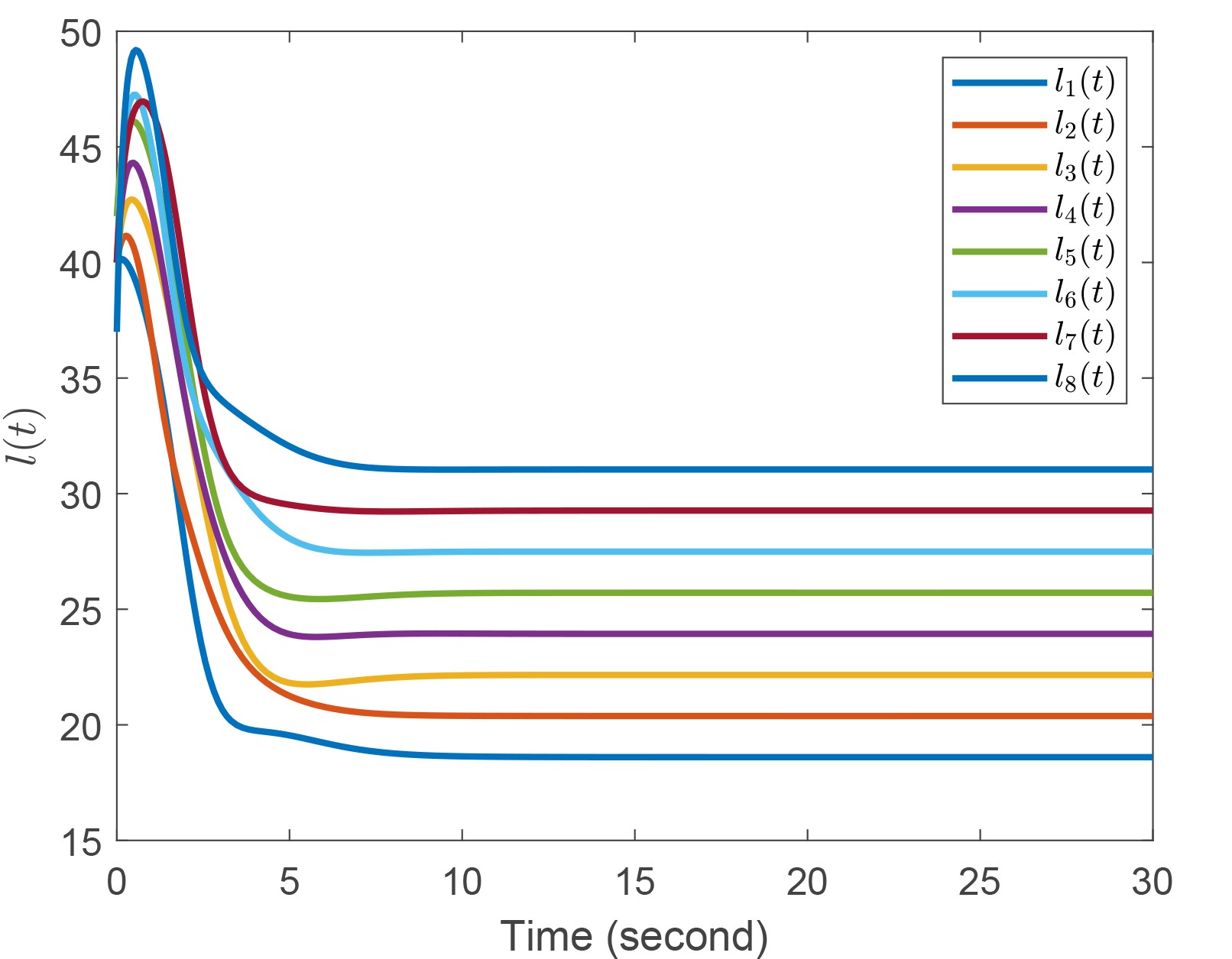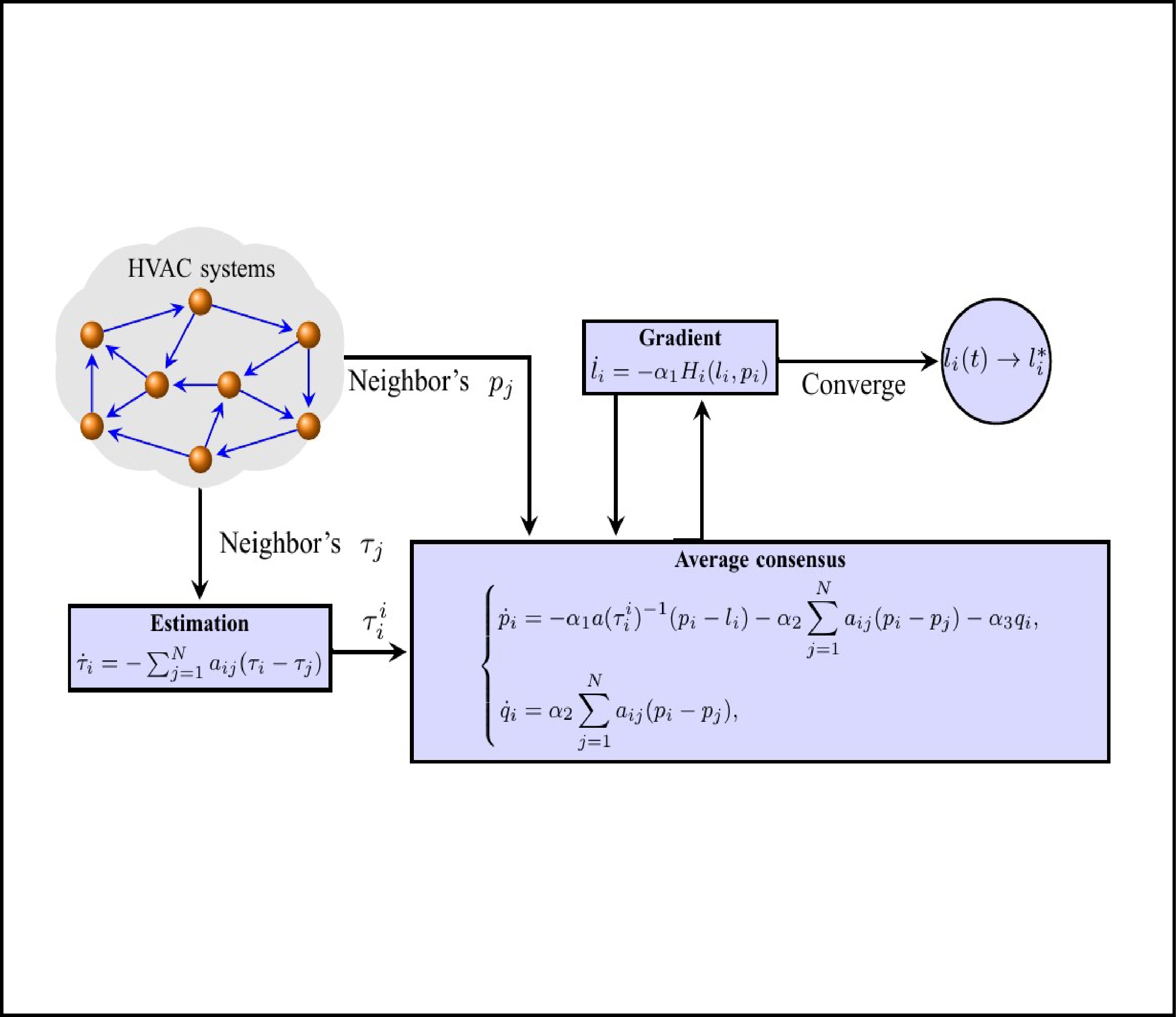
ISSN 0253-2778
CN 34-1054/N
The energy consumption problem of heating, ventilation, and air conditioning systems over general directed graphs is investigated. The considered problem is firstly reformulated as a Nash equilibrium seeking problem, and a distributed consensus-based algorithm is then proposed to solve it. To address the challenge arising from general directed graphs, a distributed estimation algorithm is embedded such that the explicit dependence on the left eigenvector associated with the eigenvalue zero of the Laplacian matrix can be avoided. Then, the exponential convergence of the proposed distributed Nash equilibrium seeking algorithm is established under a standing assumption. A numerical example is finally provided to verify the effectiveness of the proposed algorithm.

A novel distributed Nash equilibrium seeking algorithm is proposed to solve the energy consumption problem of heating, ventilation, and air conditioning systems over directed graphs
| [1] |
Li L, Sun Z. Dynamic energy control for energy efficiency improvement of sustainable manufacturing systems using Markov decision process. IEEE Transactions on Systems, Man, and Cybernetics: Systems, 2013, 43 (5): 1195–1205. DOI: 10.1109/TSMC.2013.2256856
|
| [2] |
Deng R, Yang Z, Chen J, et al. Residential energy consumption scheduling: A coupled-constraint game approach. IEEE Transactions on Smart Grid, 2014, 5 (3): 1340–1350. DOI: 10.1109/TSG.2013.2287494
|
| [3] |
Xu Z, Liu S, Hu G, et al. Optimal coordination of air conditioning system and personal fans for building energy efficiency improvement. Energy and Buildings, 2017, 141: 308–320. DOI: 10.1016/j.enbuild.2017.02.051
|
| [4] |
Rao D M K K V, Ukil A. Modeling of room temperature dynamics for efficient building energy management. IEEE Transactions on Systems, Man, and Cybernetics: Systems, 2020, 50 (2): 717–725. DOI: 10.1109/TSMC.2017.2758766
|
| [5] |
Xu J, Peter B. Luh P, Blankson W E, et al. An optimization-based approach for facility energy management with uncertainties. HVAC&R Research, 2005, 11 (2): 215–237. DOI: 10.1080/10789669.2005.10391135
|
| [6] |
Sun B, Luh P B, Jia Q S, et al. Building energy management: Integrated control of active and passive heating, cooling, lighting, shading, and ventilation systems. IEEE Transactions on Automation Science and Engineering, 2013, 10 (3): 588–602. DOI: 10.1109/TASE.2012.2205567
|
| [7] |
Qu G, Zaheeruddin M. Real-time tuning of PI controllers in HVAC systems. International Journal of Energy Research, 2004, 28 (15): 1313–1327. DOI: 10.1002/er.1030
|
| [8] |
Bai J, Wang S, Zhang X. Development of an adaptive smith predictor-based self-tuning PI controller for an HVAC system in a test room. Energy and Buildings, 2008, 40 (12): 2244–2252. DOI: 10.1016/j.enbuild.2008.07.002
|
| [9] |
Pinzon J A, Vergara P P, Da Silva L C P, et al. Optimal management of energy consumption and comfort for smart buildings operating in a microgrid. IEEE Transactions on Smart Grid, 2019, 10 (3): 3236–3247. DOI: 10.1109/TSG.2018.2822276
|
| [10] |
Ren W, Beard R W. Distributed consensus in multivehicle cooperative control: Theory and applications. Springer Publishing Company, Incorporated, 2007. https://linkspringer.53yu.com/book/10.1007%2F978-1-84800-015-5
|
| [11] |
Mei J, Ren W, Chen J. Distributed consensus of second-order multi-agent systems with heterogeneous unknown inertias and control gains under a directed graph. IEEE Transactions on Automatic Control, 2016, 61 (8): 2019–2034. DOI: 10.1109/TAC.2015.2480336
|
| [12] |
Wang Z, Wang D, Gu D. Distributed optimal state consensus for multiple circuit systems with disturbance rejection. IEEE Transactions on Network Science and Engineering, 2020, 7 (4): 2926–2939. DOI: 10.1109/TNSE.2020.3007472
|
| [13] |
Wang D, Wang Z, Wen C. Distributed optimal consensus control for a class of uncertain nonlinear multiagent networks with disturbance rejection using adaptive technique. IEEE Transactions on Systems, Man, and Cybernetics: Systems, 2021, 51 (7): 4389–4399. DOI: 10.1109/TSMC.2019.2933005
|
| [14] |
Zhu Y, Ren W, Yu W, et al. Distributed resource allocation over directed graphs via continuous-time algorithms. IEEE Transactions on Systems, Man, and Cybernetics: Systems, 2021, 51 (2): 1097–1106. DOI: 10.1109/TSMC.2019.2894862
|
| [15] |
Yu L, Xie D, Jiang T, et al. Distributed real-time HVAC control for cost-efficient commercial buildings under smart grid environment. IEEE Internet of Things Journal, 2018, 5 (1): 44–55. DOI: 10.1109/JIOT.2017.2765359
|
| [16] |
Zhang X, Shi W, Yan B, et al. Decentralized and distributed temperature control via HVAC systems in energy efficient buildings. 2017, arXiv: 1702.03308. https://arxiv.53yu.com/abs/1702.03308
|
| [17] |
He X, Fang X, Yu J. Distributed energy management strategy for reaching cost-driven optimal operation integrated with wind forecasting in multimicrogrids system. IEEE Transactions on Systems, Man, and Cybernetics. Systems, 2019, 49 (8): 1643–1651. DOI: 10.1109/TSMC.2019.2919941
|
| [18] |
Yang Y, Hu G, Spanos C J. HVAC energy cost optimization for a multizone building via a decentralized approach. IEEE Transactions on Automation Science and Engineering, 2020, 17 (4): 1950–1960. DOI: 10.1109/TASE.2020.2983486
|
| [19] |
Ma K, Hu G, Spanos C J. Distributed energy consumption control via real-time pricing feedback in smart grid. IEEE Transactions on Control Systems Technology, 2014, 22 (5): 1907–1914. DOI: 10.1109/TCST.2014.2299959
|
| [20] |
Ye M, Hu G. Game design and analysis for price-based demand response: An aggregate game approach. IEEE Transactions on Cybernetics, 2017, 47 (3): 720–730. DOI: 10.1109/TCYB.2016.2524452
|
| [21] |
Li Z, Ding Z, Sun J, et al. Distributed adaptive convex optimization on directed graphs via continuous time algorithms. IEEE Transactions on Automatic Control, 2018, 63 (5): 1434–1441. DOI: 10.1109/TAC.2017.2750103
|
| [22] |
Tang Y, Yi P. Nash equilibrium seeking under directed graphs. 2020, arXiv: 2005.10495. https://arxiv.53yu.com/abs/2005.10495
|
| [23] |
Zhang J, Liu L, Ji H. Exponential convergence of distributed optimal coordination for linear multi-agent systems over general digraphs. 39th Chinese Control Conference. Shenyang, China: IEEE, 2020: 5047-5051. https://ieeexploreieee.53yu.com/abstract/document/9189181
|
| [24] |
Hiriart-Urruty J B, Lemaréchal C. Convex Analysis and Minimization Algorithms I: Fundamentals. Berlin Heidelberg: Springer-Verlag, 1993.https://xs.dailyheadlines.cc/books?hl=zh-CN&lr=&id=Ben6nm_yapMC&oi=fnd&pg=PR5&dq=+Hiriart-Urruty+J+B,+Lemar%C3%A9chal+C.+Convex+Analysis+and+Minimization+Algorithms+I:+Fundamentals.+Berlin+Heidelberg:+Springer-Verlag,+1993.&ots=F-CuS39IuZ&sig=2m4HG9SrFhw2YJtkdGKotUZ3AAE
|
| [25] |
Godsil C, Royle G. Algebraic Graph Theory. New York: Springer-Verlag, 2001. https://citeseerx.ist.psu.edu/viewdoc/download?doi=10.1.1.479.536&rep=rep1&type=pdf
|
| [26] |
Scutari G, Facchinei F, Pang J S, et al. Real and complex monotone communication games. IEEE Transactions on Information Theory, 2014, 60 (7): 4197–4231. DOI: 10.1109/TIT.2014.2317791
|
| [27] |
Afram A, Janabi-Sharifi F. Theory and applications of HVAC control systems-A review of model predictive control (MPC). Building and Environment, 2014, 72: 343–355. DOI: 10.1016/j.buildenv.2013.11.016
|
| [28] |
Zhu Y, Yu W, Wen G, et al. Continuous-time coordination algorithm for distributed convex optimization over weight-unbalanced directed networks. IEEE Transactions on Circuits and Systems Ⅱ: Express Briefs, 2019, 66 (7): 1202–1206. DOI: 10.1109/TCSII.2018.2878250
|
| [29] |
Deng Z, Liang S. Distributed algorithms for aggregative games of multiple heterogeneous Euler-Lagrange systems. Automatica, 2019, 99: 246–252. DOI: 10.1016/j.automatica.2018.10.041
|
| [30] |
Khalil H K. Nonlinear Systems. Upper Saddle River, NJ, USA: Prentice-Hall, 2002.
|
| [31] |
Charalambous T, Rabbat M G, Johansson M, et al. Distributed finite-time computation of digraph parameters: Left-eigenvector, out-degree and spectrum. IEEE Transactions on Control of Network Systems, 2016, 3 (2): 137–148. DOI: 10.1109/TCNS.2015.2428411
|
| [32] |
Aragues R, Shi G, Dimarogonas D V, et al. Distributed algebraic connectivity estimation for adaptive event-triggered consensus. American Control Conference. Montreal, QC, Canada: IEEE, 2012: 32-37. https://ieeexploreieee.53yu.com/abstract/document/6315110
|
| [33] |
Zhu Y, Yu W, Wen G, et al. Distributed Nash equilibrium seeking in an aggregative game on a directed graph. IEEE Transactions on Automatic Control, 2021, 66 (6): 2746–2753. DOI: 10.1109/TAC.2020.3008113
|